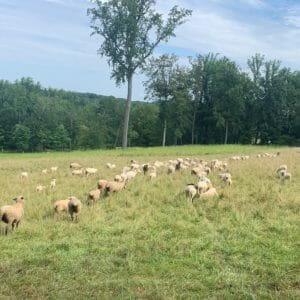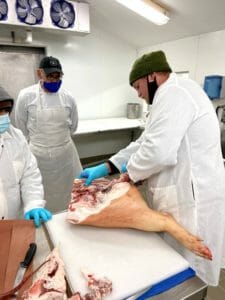
For the culmination of his work for the summer as a student worker for the Swette Center, Tucker Larson spent a week at Stone Barns Center for Food and Agriculture in Upstate New York. Read more about his visit and how it relates to what he is learning at ASU below.
A sustainable food system is far from linear. Web might be the most accurate representation. It is a flow of materials facilitated by communication networks through the system promoting resilience and diversity. When you pull on one piece of the web, the other sides start to stretch and become distorted. The makeup of each system is different and the results from interactions with one will not necessarily be the same when imposed on another. Each piece of the system and the connections they share with one another make up the foundation, determining how it can flex and adapt. Our food systems will never function sustainably if they are not understood in a larger picture, and Stone Barns Center for Food and Agriculture is working to further that understanding.
One of the many challenges that our food systems face is understanding and managing connections. At larger levels these are contracts and deals between two or more organizations or cooperatives. At smaller levels it is an agreement between a farmer, a butcher, or a local grocery store. These connections are the supply chain that are needed to manage products, understand practices, and everything in between. It is rare that you see one organization play a role in every aspect of the food system. Each piece is dramatically different and requires an independent, highly involved skillset that generally comes from years of experience. What you can do when you bring all these different operations under the same umbrella is shorten the responses in the supply chain. What could take days or weeks is cut down to minutes and hours, allowing producers and processors to see how the system is functioning in real time.

Stone Barns Center for Food and Agriculture is doing just that, connecting farmers to the kitchen and the kitchen to the plate. Their focus is on a sustainable food system with an emphasis on The Power of Deliciousness. By connecting the two concepts of sustainability and deliciousness, Stone Barns is working to reinvent food systems that work for the environment, the producer, and the consumer. The Western Barn is the center’s meat processing lab and where the butcher team works in tandem with farmers and chefs to examine products and collect information that is tied to on-farm practices. Butchers and chefs collaborate on what cuts are available and how to process the different animals ensuring a complete utilization of the carcass. These human-to-human connections making up the supply chain take a lot of energy to establish and maintain and often result in a disconnect between farmer and consumer. At Stone Barns you see regular communication between producers and some of the best chefs in the world discussing the connections between farm and plate. These condensed yet highly comprehensive supply chains that Stone Barns has created paired with their dedication to sustainability is the ideal location for food systems research.
To challenge and reimagine food systems that better serve both the environment and our growing populations, we need to understand the dynamics and impacts of food systems. Our food systems have been broken down and picked apart so that each piece can be examined individually. By compartmentalizing a system, you can determine how to minimize inputs and maximize desired outputs. Unfortunately, this is typically done in a vacuum where inputs can be viewed as unlimited and not all outputs are accounted for. The result of compartmentalized agriculture is seen in our polluted waterways, lack of biodiversity, and degraded soils. A disjointed system is one with limited resilience, as the connections throughout are concentrated to increase efficiencies. Connections are what hold the web together and allow it to shift and move as one when it is augmented. Stone Barns has brought these connections throughout their food system to one place so they can be examined. Inputs are still being minimized at Stone Barns, but outputs are understood to be so much more than an end of year harvest. Stone Barns knows the importance of these connections and puts an emphasis on understanding and fostering relationships in our food systems.

Connections are still being understood from a biological standpoint and institutions like Stone Barns are critical to further examine those relationships. As cows graze on pastures, their health is connected to the health of the pasture. The biochemically rich diets of a cow grazing on a well-maintained pasture translates into a product that has deeper, richer flavors and when butchered and cooked appropriately can be far superior. The same can be said for crop cultivation. What one plant needs and extracts from the soil; another replenishes. Plants interact with the soil just as they interact with one another, establishing intertwined root systems that exchange nutrients. Crop management can either replenish or deplete soils and how farmers manage their rotations is the deciding factor for soil health. By creating the perfect conditions in the soil and selecting the appropriate plant species to grow in harmony with the natural environment, the fruits of a farmer’s labor are allowed to express themselves in the most delicious way. Food is so much more than fuel for the human body; it fosters emotions, medicates, regulates, and connects us. Why would we assume that it is any different for plants and animals?
It’s not enough to simply produce as much as we can, focusing only on this harvest and the next. We need to provide producers with the knowledge to replenish natural systems by understanding the connections that have been overlooked by our larger food systems. We need to create systems that feed themselves and promote mutually beneficial, symbiotic relationships throughout. By working in partnership with institutions like Stone Barns, the Swette Center can better understand how these connections result in a more comprehensive system that benefits the producers, consumers, and the natural environment.